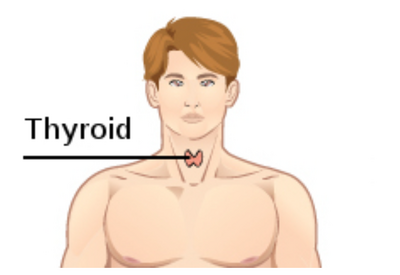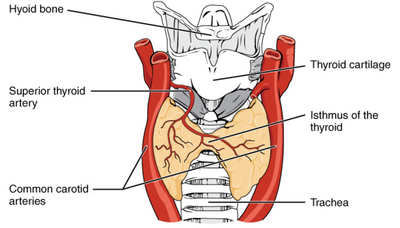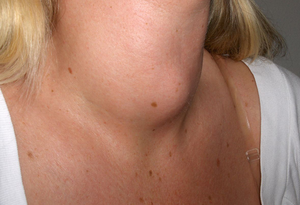Thyroid Gland
Original Editor - Niha Mulla
Top Contributors - Niha Mulla, Lucinda hampton, Kim Jackson and Carina Therese Magtibay
Introduction[edit | edit source]
The thyroid gland is a part of human endocrine system. Thyroid gland works together with the nervous system and the immune system to regulate the body metabolism by secreting hormones and releasing it into the blood stream . [1]
Anatomy[edit | edit source]
Thyroid gland is a butterfly shaped organ and is situated at the front of the neck in the lower part of the throat and consists of two connected lobes on either side of the trachea. The lower end of the lobes is connected by thyroid isthmus which is a thin band of connective tissue. [1][2] [3]
The thyroid weighs between 20 and 60 grams on average.[4][5] With each lobe being about 5 cm long, 3 cm wide, and 2 cm thick. The thyroid gland is comparatively larger in women as compared to men and also increases in size during pregnancy. The infrahyoid muscles lie in front of the gland and the sternocleidomastoid muscle to the side. Behind the outer wings of the thyroid lie the two carotid arteries whereas the trachea, larynx, lower pharynx and esophagus all lie behind the thyroid. Four parathyroid glands, two on each side, lie on each side between the two layers of the thyroid capsule, at the back of the thyroid lobes.[2]
There is loose connective tissue between the inner and the outer capsule, so the thyroid can move and change its position when we swallow.[4]
Blood supply of thyroid gland[edit | edit source]
The thyroid gland is supplied with arterial blood from:[2]
- The superior thyroid artery - a branch of the external carotid artery.
- The inferior thyroid artery - a branch of the thyrocervical trunk.
- And sometimes, by an anatomical variant the thyroid ima artery which has a variable origin.
- The superior thyroid artery splits into anterior and posterior branches supplying the thyroid, and the inferior thyroid artery splits into superior and inferior branches..[2]
Nerve supply of thyroid gland[edit | edit source]
The gland receives sympathetic nerve supply from the superior, middle and inferior cervical ganglion of the sympathetic trunk, the gland receives parasympathetic nerve supply from the superior laryngeal nerve and the recurrent laryngeal nerve.[2]
Lymphatic drainage[edit | edit source]
Lymphatic drainage frequently passes through:[2]
- Pre-laryngeal lymph nodes which is located just above the isthmus
- Pre-tracheal lymph nodes and
- Paratracheal lymph nodes.
Physiology[edit | edit source]
Thyroid gland produces three hormones:[5]
- Triiodothyronine, also known as T3
- Tetraiodothyronine, also called thyroxine or T4
- Calcitonin
Physiology of thyroid hormones:[5]
- T3 and T4 are the only proper thyroid hormones, they are made in follicular epithelial cells of the thyroid gland.
- The third hormone produced by thyroid gland calcitonin is made by c-cells.
- Iodine is the building block of both T3 and T4. Hence, dietary intake of this trace mineral iodine is vital.
- Amount of thyroid hormone required by the human body at a particular time varies; and to make the perfect quantity of thyroid hormone at any given time, the human body needs help from the pituitary gland.
Thyroid hormones affect your:[1][2][5]
- T3 and T4 increase the basal metabolic rate.
- T3 and T4 promote physical and mental growth in children.
- Calcitonin is involved in calcium and bone metabolism.
- Thyroid hormones activate the nervous system which improves concentration.
- Thyroid hormone affects your: body temperature and circulation, appetite, energy levels, growth and bone development, muscle tone and suppleness, heart rate, blood sugar levels, central nervous system and bowel function, cholesterol levels, fat, carbohydrate and protein metabolism.
- Higher the amount of T3 and T4 in the body, higher is the body metabolism. If the level of T3 and T4 drops in the body, so does the rate of metabolism.
Iodine for thyroid hormone[edit | edit source]
- Human body need iodine to create the thyroid hormone. As we know iodine is the building block of both T3 and T4.
- This trace mineral cannot be produced by the human body.
- Hence, dietary intake of iodine is vital.
- Iodine is absorbed into the blood stream from food and bowel, from where it is carried to the thyroid gland to be used by the thyroid gland in due course. [1][5]
The pituitary gland and thyroid hormone[edit | edit source]
- The pituitary is an endocrine gland that is located at the base of your brain.
- It controls the endocrine system.
- It effects the thyroid by producing a hormone called thyroid stimulating hormone (TSH).
- TSH stimulates the thyroid gland to produce right amount T3 and T4.
- If there is more amount of T4 present in ones blood stream, the pituitary gland will produce less TSH which will slow down the thyroid activity leading to less production of T4. Whereas, if the level of T4 hormone is less then required amount in they body, the pituitary gland will produce higher quantity of TSH to boost the metabolism and production of thyroid hormone.[1]
Hormone imbalances: Overactive and underactive thyroid gland[edit | edit source]
Overactive thyroid ( hyperthyroidism) occurs if the thyroid gland produces thyroid hormones in excess. And an underactive thyroid (hypothyroidism) is where the thyroid gland does not produce enough thyroid hormones.[5]
Overactive thyroid (hyperthyroidism):[1][2][6][5][7][8]
- Rapid pulse
- Hand tremors
- Sweating more than normal
- Feeling hot
- Increased appetite
- Weight loss
- Nervousness
- Increased agitation and anxiety
- Diarrhoea
- Bulging eyes
- Goitre
Underactive thyroid (hypothyroidism):[1][2][6][5][7][8]
- Feeling tired and fatigued
- Feeling cold even on warm days
- Weight gain
- Depression
- Reduced concentration
- Brain fog
- Puffy face
- Hair loss
- Dry skin
- Constipation
- Hoarseness
- Elevated blood cholesterol level
- Muscle aches, tenderness and stiffness
- Pain, stiffness or swelling in your joints
- Heavier than normal or irregular menstrual periods
- Goitre
- Congenital hypothyroidism must be treated urgently to avoid serious brain damage and promote optimal physical and mental development. Hence, all newborn babies are now screened for this condition.[7]
- In infants hypothyroidism can cause yellowing of skin, difficulty breathing, hoarse crying and umbilical hernia.
- In children and teens hypothyroidism causes poor growth, delayed development of permanent teeth, poor mental development and delayed puberty. [9]
Risk factors of hypothyroidism:[9][10]
- Being a woman.
- Individual older than 60 years of age.
- A family history of thyroid disease.
- Autoimmune disease, such as type 1 diabetes or celiac disease.
- Treated with radioactive iodine or anti-thyroid medications.
- Have received radiation to your neck or upper chest.
- Thyroid surgery like partial thyroidectomy.
- Pregnancy (during pregnancy or up to 6 months after birth).
Goitre[edit | edit source]
- Goitre is defined as significantly enlarged and swollen thyroid gland.[1]
- It is commonly seen in patients with iodine deficiency.[1]
- As the pituitary gland tries to over-compensate by over stimulating the thyroid gland to produce more hormone, the thyroid gland happens to grow larger and larger as it tries to produce more thyroid hormones. [1][7]
- Goitre can also be associated with Hashimoto’s thyroiditis, a condition related to thyroid gland inflammation. Hashimoto’s thyroiditis is an autoimmune disorder. [8][11]
Other thyroid gland conditions[edit | edit source]
- Graves’ disease: An autoimmune condition in which the thyroid is overstimulated, causing hyperthyroidism. It also may cause inflammation and swelling of the tissue around the eyes. Rarely, it causes skin problems as well .[1][3][6]
- Hashimoto’s disease: It is an autoimmune condition which causes inflammation in the thyroid gland and is the most common cause of hypothyroidism. It may also cause a goiter. [1][3]
- Thyroid cancer: It is an uncommon form of cancer, which is usually treatable and curable by Surgery, radiation, and hormone treatments.[1][3][6]
- Thyroid nodules: It is a small abnormal mass or lump in the thyroid gland. Thyroid nodules are extremely common, a few of which are known to be cancerous. They are known to secrete excess hormones, causing hyperthyroidism, or cause no problems at all. [1][3][6]
- Congenital thyroid disease: It is an extremely rare condition where, some babies are born with a defective thyroid gland or no thyroid gland at all. In most cases, the thyroid gland won’t develop normally for unknown reasons, It may be an inherited disorder. Often, infants with congenital hypothyroidism appear normal at birth. That's one reason why most states now require newborn thyroid screening. [1][10]
- Iodine deficiency disorder: The trace mineral iodine is essential for the production of thyroid hormones. Too little iodine can cause hypothyroidism, and too much iodine can worsen hypothyroidism in people who are already suffering from the condition. [1][10]
- Thyroid storm: It is a rare form of hyperthyroidism in which extremely high thyroid hormone levels cause severe illness.[6]
- Pituitary disorder: It is a very rare form of hypothyroidism in which failure of the pituitary gland to produce enough thyroid-stimulating hormone (TSH) causes hypothyroidism. Mostly it happens because of pituitary gland tumor (which is mostly benign).[10]
- Pregnancy and postpartum: women develop hypothyroidism as their body produces antibodies to their own thyroid gland. If left untreated it can cause miscarriage, premature delivery and preeclampsia. It can also cause defects in the developing fetus. [2][10]
Stress and thyroid gland[edit | edit source]
- Being too much stressed can affect the thyroid gland and can cause hypothyroidism, as stress reduces the ability of the thyroid gland to produce adequate hormone levels known as thyroxine.
- As a result, thyroid gland is not able to efficiently control the body metabolism, which further causes a range of health issues.
- As stress increases, body produces the stress hormone called “cortisol” and excessive amount of cortisol interrupts the production of thyroxine, further effecting the hormone conversion to triiodothyronine.[12]
- Hence, stress can be linked to symptoms of hypothyroidism, leading to weight gain, fatigue, brain fog, difficulty in concentration and depression.
- To reduce stress, it is advised to eat healthy and reduce consumption of alcohol, caffeine, salt and sugar. Drink 2 to 3 liters of water every 24 hours, along with eating three meals every day at same time.
- Exercise is known to reduce stress hence adding at least 20 minutes of exercise to your routine is advisable.
- Adequate sleep with a consistent bedtime routine is a vital to combat stress.
- It is advised to maintain a routine and plan achievable daily tasks, to keep on top of everything as stress and hypothyroidism both can further lead to depression. [12]
Thyroid tests[edit | edit source]
- Anti-TPO antibodies test is done to check autoimmune thyroid disease, where a proteins mistakenly attacks the thyroid peroxidase enzyme, which is used by the thyroid to make thyroid hormones.
- Thyroid gland ultrasound.
- Thyroid scan with radioactive iodine.
- Thyroid biopsy , where a small amount of thyroid tissue is removed usually by using a needle, to look for thyroid cancer.
- Thyroid stimulating hormone (TSH) test, where a blood test commonly used to detect hypothyroidism or hyperthyroidism.
- T3 and T4 (thyroxine) test, where the primary form of thyroid hormone is checked with a blood test.
- Thyroglobulin test, where a substance secreted by the thyroid that can be used as a marker of thyroid cancer is measured. High levels indicate recurrence of the cancer hence is test is usually conducted on thyroid cancer follow up patients.
- Other imaging tests: If thyroid cancer has spread (metastasized), tests such as CT scans, MRI scans, or PET scans are carried out to help identify the extent of spread of thyroid cancer. (Thyroid tumor is usually rare and mostly benign) . [2][6]
Treatments for thyroid gland disorders[edit | edit source]
- Thyroidectomy is performed by a surgeon to remove all or part of the thyroid gland. Thyroidectomy is performed on patients that are suffering from thyroid gland cancer, goiter, or hyperthyroidism.
- Drugs can slow down the overproduction of thyroid hormone in hyperthyroidism. Two common anti-thyroid medicines are methimazole and propylthiouracil.
- Radioactivity iodine can be used in low doses destroy an overactive gland, whereas large doses can be used to destroy cancerous thyroid gland tissue.
- External radiation to treat thyroid gland cancer, is a form of treatment where a beam of radiation is directed at the thyroid, on multiple appointments. These high-energy rays help kill thyroid cancer cells.
- Thyroid hormone pills are a daily treatment that replaces the amount of thyroid hormone you can no longer make. Thyroid hormone pills treat hypothyroidism and are also used to help prevent thyroid cancer from coming back after treatment. It is a synthetic thyroid hormone levothyroxine (Levo-T, Synthroid, others). This oral medication restores adequate hormone levels. [6]
- Healthy eating is essential, hence one should reduce the intake of alcohol, caffeine, salt and sugar. One should drink 2-3 liters of water and eat three proper meals in a day that are high is fiber and proteins instead of carbohydrates. [12]
- Having enough sleep is vital, as without adequate rest it is difficult to concentrate on daily living activities and lead to feeling excessively fatigued; which in turns increases stress. [12]
- Stress management is most important as increased level of stress along with abnormal level of thyroid hormone levels is a bad combination, as it makes performing daily living activities more difficult.[12]
Rehabilitation and its effects on thyroid gland function[edit | edit source]
Physiotherapy can help in the treatment of hypothyroidism as exercise can help improve metabolism and reduce weight. An individual/patient can join group exercise classes at least 3-4 days a week are perfect for anyone looking to take control of their hypothyroidism. [13][14][15][16]
Hypothyroidism makes an individual feel sluggish as fatigue makes an individual rest a lot more than normal. This in turn contributes to muscle loss, poor posture, and pain; decrease in muscle strength further leads to poor balance and posture. Hence, exercise to improve muscle strength and posture is vital. [13][14][15][16]
Studies have shown that "Physical activity influences energy metabolism in human subjects by increasing activity-induced energy expenditure and resting metabolic rate for several hours after exercise." [14]
All exercises should be started gradually and if the thyroid levels are well under control one should be able to do the same physical activity as someone without a thyroid disorder. some forms of exercises that can be made part of daily or weekly routine are walking, aerobic exercises, water activities, yoga, Tai chi and strength training. [15][16]
References[edit | edit source]
- ↑ 1.00 1.01 1.02 1.03 1.04 1.05 1.06 1.07 1.08 1.09 1.10 1.11 1.12 1.13 1.14 1.15 The thyroid gland. Government of Western Australia, Department of Health. Available from https://www.healthywa.wa.gov.au/Articles/S_T/The-thyroid-gland
- ↑ 2.00 2.01 2.02 2.03 2.04 2.05 2.06 2.07 2.08 2.09 2.10 Thyroid. Wikipedia. Wikimedia Foundation; Available from: https://en.wikipedia.org/wiki/Thyroid
- ↑ 3.0 3.1 3.2 3.3 3.4 Brady B. Thyroid gland: Overview. Endocrine web. 2019 . Available from: https://www.endocrineweb.com/conditions/thyroid-nodules/thyroid-gland-controls-bodys-metabolism-how-it-works-symptoms-hyperthyroi
- ↑ 4.0 4.1 ESCOBAR GM, Pastor R, Obregón MJ, REY FE. Effects of maternal hypothyroidism on the weight and thyroid hormone content of rat embryonic tissues, before and after onset of fetal thyroid function. Endocrinology. 1985 Nov 1;117(5):1890-900.
- ↑ 5.0 5.1 5.2 5.3 5.4 5.5 5.6 5.7 How does the thyroid gland work? InformedHealth.org U.S. National Library of Medicine; 2018 . Available from: https://www.ncbi.nlm.nih.gov/books/NBK279388/
- ↑ 6.0 6.1 6.2 6.3 6.4 6.5 6.6 6.7 Hoffman M. The thyroid (human anatomy): Picture, function, definition, location in the body, and more. WebMD. WebMD; 2021. Available from: https://www.webmd.com/women/picture-of-the-thyroid
- ↑ 7.0 7.1 7.2 7.3 Thyroid gland - Better Health Channel. Victoria state government, Department of health; 2015. Available from: https://www.betterhealth.vic.gov.au/health/conditionsandtreatments/thyroid-gland#bhc-content
- ↑ 8.0 8.1 8.2 Ahmed R, Al-Shaikh S, Akhtar M. Hashimoto thyroiditis: a century later. Advances in anatomic pathology. 2012 May 1;19(3):181-6.
- ↑ 9.0 9.1 Mann NP. Congenital hypothyroidism–what’s new?. Paediatrics and Child Health. 2011 Jul 1;21(7):295-300.
- ↑ 10.0 10.1 10.2 10.3 10.4 Hypothyroidism (underactive thyroid). Mayo Clinic. Mayo Foundation for Medical Education and Research; 2020. Available from: https://www.mayoclinic.org/diseases-conditions/hypothyroidism/symptoms-causes/syc-20350284#:~:text=Your%20thyroid%20is%20a%20small,all%20aspects%20of%20your%20metabolism
- ↑ Teng M. Common thyroid disorders and thyroid self-examination [Internet]. Endocrine web. 2015 [cited 2022Feb12]. Available from: https://www.endocrineweb.com/conditions/thyroid-nodules/common-thyroid-disorders-thyroid-self-examination
- ↑ 12.0 12.1 12.2 12.3 12.4 Stress is Affecting Your Thyroid. Thyroid australia. 2018. Available from: http://www.thyroid.org.au/
- ↑ 13.0 13.1 Exercises for hypothyroidism. Graceville Physio. 2022 . Available from: https://gracevillephysio.com.au/blog/physio/physiotherapy-nutrition-hypothyroidism/#:~:text=Physiotherapy%20can%20help%20in%20the,take%20control%20of%20their%20hypothyroidism.
- ↑ 14.0 14.1 14.2 Ciloglu F, Peker I, Pehlivan A, Karacabey K, İlhan N, Saygin O, Ozmerdivenli R. Exercise intensity and its effects on thyroid hormones. Neuroendocrinology letters. 2005 Dec 1;26(6):830-4.
- ↑ 15.0 15.1 15.2 Aprile I, Romitelli F, Piazzini DB, Padua L, Lancellotti S, Maggi L, Zuppi C, Bertolini C, Di Stasio E. Effects of rehabilitation treatment on thyroid function. Clinical endocrinology. 2009 Apr;70(4):644-9.
- ↑ 16.0 16.1 16.2 Exercises for hypothyroidism. Graceville Physio. 2022. Available from: https://gracevillephysio.com.au/blog/physio/physiotherapy-nutrition-hypothyroidism/#:~:text=Physiotherapy%20can%20help%20in%20the,take%20control%20of%20their%20hypothyroidism.









